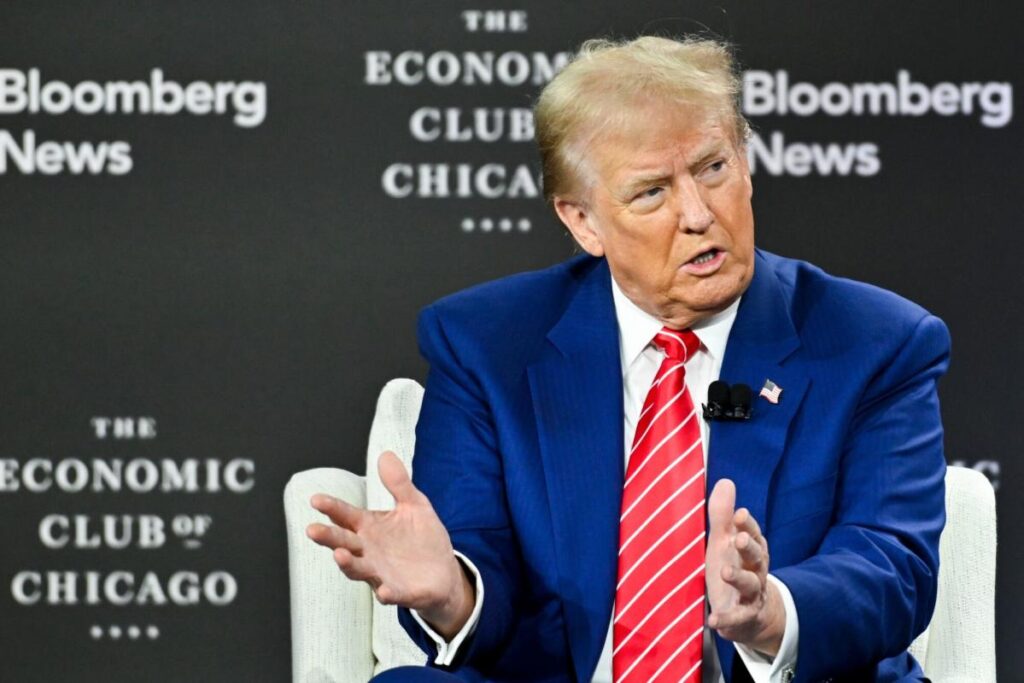In a recent interview with Bloomberg News Editor-in-Chief John Micklethwait at the Economic Club of Chicago, former US President Donald Trump discussed his economic policies and their potential for growth while acknowledging concerns about rising debt and inflation. Trump asserted that his administration would focus on stimulating growth by repatriating companies to the United States. He emphasized his intention to implement significant tariffs on foreign imports, insisting that these measures would protect domestic businesses and jobs, countering the argument that tariffs would harm jobs reliant on trade. According to Trump, increased tariffs would encourage companies to establish factories domestically to avoid the costs associated with tariffs, leading to job creation.
As the election approaches, polling indicates that Trump is capitalizing on widespread dissatisfaction with President Joe Biden’s economic performance. Voter concerns over inflation and job security seem to favor Trump’s economic approach over that of his opponent, Democratic Vice President Kamala Harris. To galvanize support from business executives and the electorate, Trump has pledged to aggressively pursue deregulation, renew tax cuts, lower corporate tax rates from 21% to 15%, and introduce new tax benefits aimed at enhancing domestic manufacturing. However, these proposals come with significant fiscal implications, offering potential increases to an already historic federal deficit nearing $2 trillion.
Central to Trump’s economic strategy is a bold agenda of tariffs aimed at both allies and adversaries, proposing rates as high as 60% on Chinese imports. While Trump argues that these tariffs can fund tax reductions and contribute positively to the economy, many economists warn they could backfire by straining international trade and, ultimately, exacerbating inflation. There is skepticism regarding whether the proposed tariffs would generate enough revenue, as it’s projected they could yield about $200 billion annually, while the federal revenue for fiscal 2024 was around $4.9 trillion. Critics point out that these tariffs may effectively act as a tax hike for households, constraining consumer spending and prompting the Federal Reserve to adjust interest rates upward.
In addressing the Federal Reserve’s role and its leadership under Jerome Powell, Trump expressed his belief that a president should have input on interest rates. Notably, he refrained from outright calling for Powell’s removal but criticized the Fed’s handling of inflation rates. Critiques of the Fed’s decisions have been a hallmark of Trump’s economic narrative, particularly as he navigates a tightening election landscape. By promoting a more hands-on approach, Trump underscores a significant shift in historical practice where the Fed operates independently from political influence—a move that could potentially challenge longstanding principles in monetary policy.
Moreover, Trump’s commentary extended to recent issues involving Big Tech, particularly his views on Google and its monopolistic power in the search engine market. While he stopped short of advocating for a breakup of the company, Trump suggested reforms to ensure fairness in how platforms operate, reflecting a growing concern among conservatives about the influence of major tech firms. This aligns with his broader strategy of engaging and mobilizing voters by addressing platforms that he believes treat him and his supporters unfavorably.
On immigration, Trump proposed a rigorous crackdown on undocumented migrants, pledging to complete the border wall and reinstate restrictions from his previous administration. However, some business leaders voiced concerns that his hardline approach could exacerbate labor shortages, complicating hiring processes for companies dependent on migrant labor. Trump reiterated the need for legal immigration while stressing national security concerns, hinting at a complex balancing act between his immigration policies and their economic repercussions. As the election heats up, Trump’s ability to connect with various voter demographics, including communities of color and suburban voters, may significantly influence the outcome of the closely watched 2024 presidential race.

